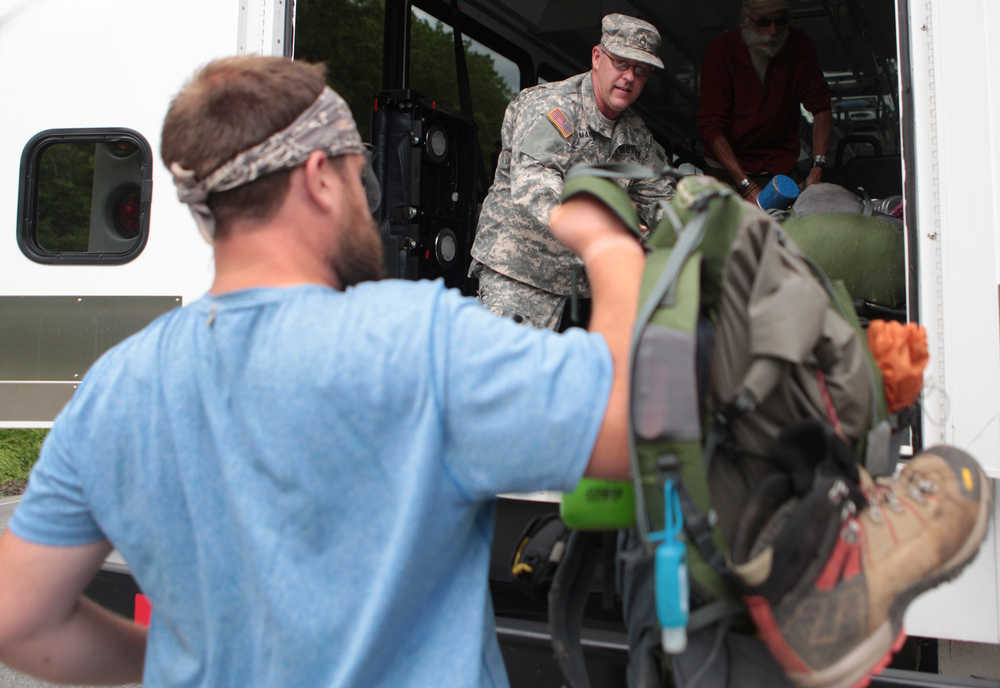ROANOKE, Va. — After three combat deployments in a dozen years, Sean Gobin stepped onto the Appalachian Trail in Georgia to walk off the war.
Six months and more than 2,000 miles later, Gobin made it to Katahdin, Maine. Time enough to do plenty of thinking.
Gobin is hardly the first combat veteran to “walk off the war.” Earl Shaffer, the first documented through-hiker on the AT in 1948, reportedly set out to do just that.
Gobin has taken it a step further.
He founded the Warrior Hike to coordinate hikes for other veterans who are struggling to adapt to civilian life. This spring, 26 veterans set off on hikes along the AT, the Continental Divide Trail and the Pacific Crest Trail.
On May 17, Gobin drove his motorcycle from Charlottesville, where he just graduated from the University of Virginia’s Darden School of Business, to the parking area for the McAfee Knob trail along Virginia 311 to meet up with this year’s AT hikers.
Fourteen veterans embarked on the journey on March 17 — half have hiked the 700 or so miles into the Catawba Valley. Two who dropped out earlier because of injuries are expected to rejoin the group.
While waiting on Gobin and on a bus to take them to the Veterans of Foreign War Post 1264 in Roanoke, the hikers gathered around the open trunk of another hiker veteran who brought in supplies: Twinkies and Pabst Blue Ribbon.
For most of the week, each man is off to himself; sometimes a few will meet up at night, but all gather at an appointed time each weekend to keep with the schedule that will get them to the end of the trail on Sept. 12 and to visit with veterans in trail towns who want to lend their support.
Several said that while they are grateful for the hospitality and the meals, sometimes it’s a bit much.
“I appreciate the people think enough of us to provide a meal and sometimes a place to eat and that they appreciate that we were willing to die for our country,” said Jamey Pierson of Elmira, New York. “But when you get to a town, you just want to shower, do your laundry and relax.”
Pierson spent 24 years in the Air Force, six of them on duty at Dover Air Force Mortuary and at Walter Reed, and had thought about hiking the AT alone when he found out about the Warrior Hikers.
“For the most part, you walk during the day by yourself. There are a lot of ups and downs, personalities to figure out,” he said. “We have our arguments like anything else in life.”
Todd Rogers of East Greenbush, New York, said he struggled to adjust to civilian life.
“I had a ridiculous hard time. At one time I was on 11 different medications. Some of them counteract each other. The doctors don’t talk to each other,” Rogers said. “I couldn’t sleep. I had anger issues and anxiety, and a tremendous amount of social anxiety.”
The trail is different.
“This is nice to be out here. Everyone you talk to out here has things in common. Like where are you going to find the next water source. Whether it’s going to rain,” he said.
“There are no computers, TVs, cellphones that constantly have your attention,” Gobin said. “You’re just hiking eight hours a day, day after day, week after week, month after month, so your brain doesn’t have any other choice but to process everything you’re going through. That’s what is really therapeutic. Having to go see a counselor at 4 p.m. on a Tuesday and sit in a cubicle and talk at length about something you’re not really comfortable talking about isn’t necessarily the way people want to come to terms with their wartime experiences.”
Gobin’s hike came just a few months after his last deployment. Two years later, he understands better why it’s so hard for so many veterans several years later.
“Usually, when you first get home, there’s an immediate transition into whatever civilian job or school. A couple years down the road, you realize things aren’t the same,” he said.
“You leave a part of your humanity in the battlefield. That’s the best way to verbalize it,” he said. “You need to figure out a way to come to terms with it or get that piece back. So there needs to be some kind of transitional experience where you can regain that faith in humanity, reconnect with society and have that camaraderie that you lost when you got out.”
Hiking the AT is not a cure for PTSD, he said.
“It’s a matter of coping, coming to terms with what your wartime experiences were. So this is more of a reset button. When you get back to the world and you feel the stresses building up, it’s easy and it’s free to take off to nature. It’s a coping strategy. It’s accessible. It’s free.

